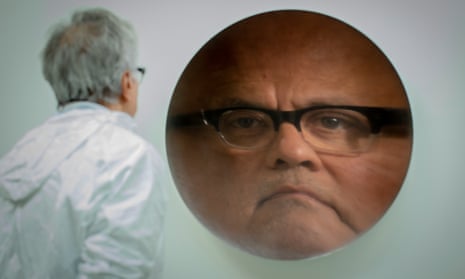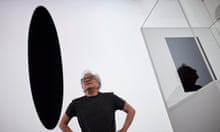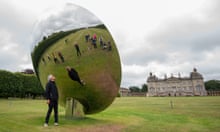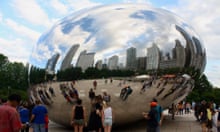At 7.30 on the morning after Britain voted to leave the European Union, Anish Kapoor left his London flat for an appointment with his analyst. On the street, he heard two men talking. “Bet he doesn’t even speak English,” said one. “I turned around and they were talking about me. I was so furious.”
Sir Anish Mikhail Kapoor, CBE, RA, the 65-year-old, Turner prize-winning, Mumbai-born British-Indian artist, who has lived in London since the early 1970s and (though this is hardly the point) speaks better English than most of his countrymen, had woken up in a new land. “Since then permission has been given for difference, rather than being celebrated, to be undermined.”
Kapoor’s latest exhibition, a suite of mirrors and other discombobulating reflective sculptures, some inspired by Lewis Carroll, opens on Saturday at Pitzhanger Manor in London. Like Alice, Britain has gone through the looking glass, splintered its image and emerged in darkness.
Last year, a visitor to the Serralves museum in Porto jumped with Kierkegaardian heedlessness, into another of Kapoor’s works, a 2.5-metre circular hole called Descent Into Limbo, fell eight feet and had to be taken to hospital. Perhaps that’s an unwitting allegory too: Britain is broken, and is now stuck in the eternal limbo of Theresa May’s Brexit strategy.
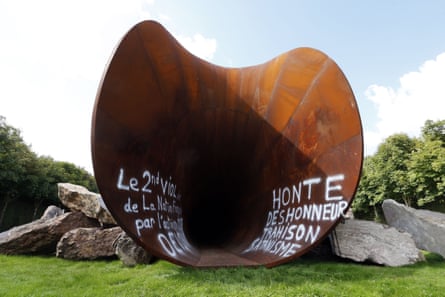
The sense of being diminished for the colour of his skin in a resurgently racist Britain is one reason Kapoor has decided to campaign for Shamima Begum, the young Londoner who joined Isis in Syria aged 15 and has since had three children die there, most recently her three-week-old son, Jarrah. “One of the good things about Britain is that people from all over the world lived here, reasonably tolerantly with different views,” says Kapoor. “Increasingly that’s less likely to be the case. We’re seeing a kind of enforced normality where you have to prove you’re a real Brit in some way that fits the populist agenda. Come on! Britons are better than that.”
Kapoor is not Muslim, but Jewish (he was born to a Jewish mother of Iraqi ancestry and a Hindu father). Nevertheless, Begum’s case resonates with him. “There’s this real sense for me of who’s next? There’s an atmosphere of vilifying Muslims for having extreme views. If I was a young Muslim, would I feel angry enough to have joined Isis? I would at least think about it.”
Kapoor has experience of being vilified as an artist. In 2015 he installed Dirty Corner, a vast steel funnel made for the gardens of Versailles, a sculpture he described as “the vagina of the queen”. He intended it to disrupt landscape gardener André Le Nôtre’s perfect geometric perspectives. “Before it opened I did an interview with the psychoanalyst Julia Kristeva in which I said I wanted to create some unease in this ordered space. It worked beyond my wildest dreams. Within two weeks it was covered with graffiti, which we cleaned off. We’d hardly finished when antisemitic graffiti appeared on it.”
The sculpture and surrounding rocks were sprayed with such phrases as “SS blood sacrifice” and “the second RAPE of the nation by DEVIANT JEWISH activism”. Kapoor decided not to erase them, but to display the ugliness manifested, the return of the repressed.
“I felt from the start this was an inside job. They have cameras everywhere, but when we asked the police to open an investigation they found nothing. I say phooey to that.” Then a councillor took Kapoor to court, bizarrely accusing the artist of displaying antisemitic material. He was invited for an audience at the Élysée Palace with then President François Hollande.
“It was around the time Isis bombed Palmyra” – the ruins of an ancient city that for 1,500 years had been one of the best preserved sites from antiquity. “So I said, ‘Mr President, the thing to do is call on people in France to speak out against the destruction of culture.’ And he replied, ‘C’est vous qui devriez le faire.’ It’s you who must do it. I thought, ‘Pathetic shit.’ Then he asked me to remove the graffiti. He said, ‘From a pedagogic point of view I understand what you are doing, but as a citizen I cannot agree.’ Complete waste of time!”
In the end Kapoor covered the bits of graffiti that were prominent with gold leaf – gold leaf being Louis XIV’s go-to decorative material. Just enough not to land him in jail.
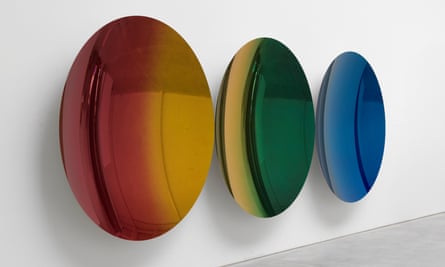
What about antisemitism this side of the Channel – does Kapoor have compunctions about Labour leader Jeremy Corbyn? “No. I’m Jewish and I believe he has done his best on this. He’s an anti-Zionist. And you can be anti-Zionist and pro-Palestinian without being antisemitic.” Kapoor suspects this is a distraction from a bigger political issue. “What this all misses is that we have probably the most rightwing government in Europe. If Corbyn comes to power he will be the first prime minister since Thatcher to believe people matter more than or as much as business. Blair was just a continuation of Thatcher. And that matters because the biggest polluters of our world are all big businesses.”
Sporting a hazmat suit, Kapoor guides me through his vast warehouse complex near the Oval cricket ground in London. Masked assistants, like a dozen Jesse Pinkmans to his Walter White, are cooking up not crystal meth, but carefully buffed painted mirrors, blood-red resin sculptures that look like placentas, and a work consisting of what Kapoor calls a hair of metal shards overlaying a dark conic space.
We pause before a large sculpture consisting of fabric folded in on itself on a mesh carapace. The fabric is curled up like a bouquet of roses, dark spaces between each petal. It’s an unsettling variation on a theme that increasingly obsessed Kapoor in recent years: the negative space opened up by folds in fabric, paper, any material. While early folded works, such as the 2016 etching Fold IV, were riffs on open books (or just possibly variants on his Versailles vagina, but certainly not at all phallic) this piece is a symphony of holes that contain more than you’d think.

“The story we were told at art school is that the Renaissance’s great discovery was perspective. But there’s another aspect, which is the fold. Being is represented in the involuted fold. The body of the Madonna is represented by the fold of her cloak.”
We should, Kapoor tells me, look into the spaces between. “We live in a world of phallic objects. It’s as if Brancusi’s modernism led to the rocket, the forward-thrusting. I’m anti-phallic. Plato wanted to lead us out of the cave into the light. But what about the back of the cave, the upside down which is dark, perhaps even menacing and abject?” His is the art of stranger things, with Kapoor as sculpture’s answer to Joyce Byers excavating voids into uncanny realms.
“I am the luckiest man alive,” he says, as we stroll through the studios. “In the 60s there were perhaps five artists – Francis Bacon, Henry Moore and a few others – who could live by making art. Now the art world is huge and everything is for sale. I expected to spend my life teaching art rather than being able to be an artist.”
But you’re an artist making commodities even though you despise neoliberal commodification. “It’s a system I’ve benefited from, no question. We risk becoming further cogs in the wheel of production. Only poetry and the more serious classical music seem able to resist becoming commodities. There’s a sense that art has been eroded by the market. The world that Steve Bannon wants is here. And it’s our fault.” Whose? “Liberal lefties like me. I’m going to dare the art world is a part of it.” Part of what? “The ruin of art’s ability to stand opposed to the order of things.”
It is as if art had fallen, bewitched by its own reflection, into Narcissus’s pool. Which brings us back to Pitzhanger Manor. It’s a brilliant coup to get the modern master of mirrors to do the first show at architect Sir John Soane’s former country house after its lottery-funded refurbishment. Soane’s spaces, after all, involve a play of mirrors “to infer a multitude of elsewheres”, as artist Mark Pimlott puts it in his essay for the show.
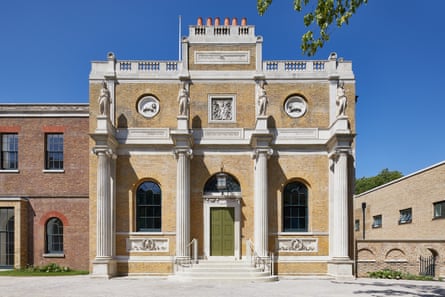
Kapoor’s mirrors are mostly concave, Soane’s convex or flat. Where Soane’s mirrors point beyond or back, Kapoor’s point within. It’s Nietzschean: we look into the abyss, and the abyss stares back.
Kapoor likes that idea. “Perhaps that is the mission of the artist – to make something that isn’t knowable, that bears long looking, that’s a dangerous thing, a deep space full of darkness.” Such is his best art: mirrors that trap, voids that eat you up, bloody wall hangings that menace.
Kapoor thinks once more of the Portuguese man who fell into a hole. “Bless him, poor soul, he thought it was an illusion, even though he’d been given a piece of paper to tell him it was eight feet deep. And then he jumped in as if to prove it wasn’t. In a way I was 100% successful. Art had taken him somewhere unexpected.”
